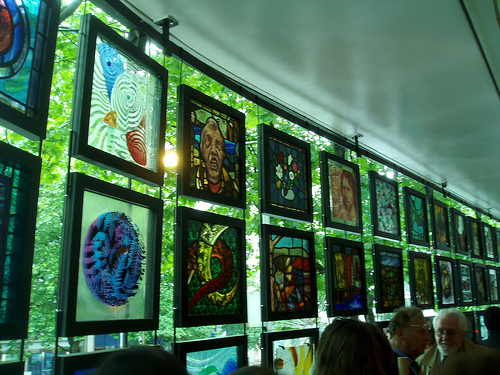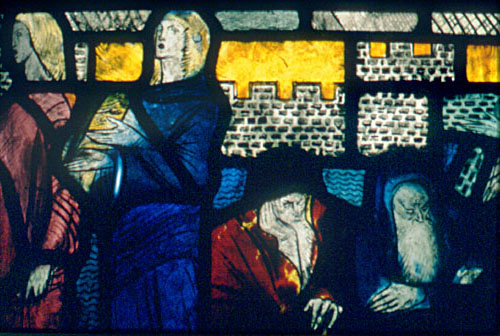August 30, 2008
NPR - how to tell the economy is weak.
Duluth Sells Historic Window To Make Ends Meet, a segment on NPR's All Things Considered today about the city of Duluth, Minnesota selling a Tiffany window to raise cash for the government coffers. More details in the article, Can she save the city?, on the Duluth News Tribune website. At least one thing was factually wrong in the NPR report. Figural designs in Tiffany windows are not nearly as rare as was suggested by the Duluth representative.
The figure is of Minnehaha, the fictional character from the poem The Song of Hiawatha, by Henry Wadsworth Longfellow.

and a detail found on Flickr

With him dwelt his dark-eyed daughter,
Wayward as the Minnehaha,
With her moods of shade and sunshine,
Eyes that smiled and frowned alternate,
Feet as rapid as the river,
Tresses flowing like the water,
And as musical a laughter:
And he named her from the river,
From the water-fall he named her,
Minnehaha, Laughing Water.
I've never read the full poem, but mainly know it from its many parodies. My favorite being Lewis Carroll's version, Hiawatha's Photographing.
[update October 7, 2008 - The New York Times picks up on the story and puts it in context with the broader economic situation - Financial Crisis Takes a Toll on Already-Squeezed Cities. Bonus for the SG enthusiast - they have an image of the full window.]
[update- Oct 16, 2008, good news - Duluth takes for sale sign off 'Minnehaha' window
]
August 29, 2008
40cm2 Exhibition on Flickr
I'd heard about this '40cm2 Exhibition' of works by members of the British Society of Master Glass Painters, but could never find any images, until today.
This is from the 40cm2 Exhibition Flickrset by Flickrite Aidan McRae Thomson.

I wish we would do exhibitions like this is the good old USA...sigh.
Aidan's own work at the exhibition -

Very nice work.
I came across his work before when I did an update to my recent post on Millenium Windows in the UK. Aidan did a millenium window that was, sadly, destroyed in a fire earlier this year.
Also - make sure to also check out his other stained glass sets. Lots of good stuff for the SG enthusiast.
August 27, 2008
AGG2008- the quick overview
Hard to believe it's been over 3 weeks since I attended the 2008 American Glass Guild Conference - and I still haven't posted anything yet! Sorry. Crazy busy days. Fact is, I starting writing and it turns out I have enough material for several posts.
So today, it's just the quick overview. and a few photos.
Unfortunately, I could only make it for the one day - Saturday, August 2nd. Early in the morning, thanks to Ken Leap, I was lucky enough to be part of a group given a kind of practice tour of the Glencairn Museum - practice for the official stained glass tour the conference had on Monday. The house and its collection are truly amazing. I'd been to Glencairn before but it was great to see it again and to see some of the glass-making related stuff that Ken has unearthed. Longer post in process.
After the museum, on the way to the conference, we (Dan Maher, Nancy Nicholson and myself) stopped to pick up Judith Schaechter at her home/studio in Philadelphia, and we got a quick tour and a sneak peek at her now installed MAD commission before we were off to the conference. Again, longer post in process, along the lines of my open studio visits.
The first speaker I heard was Nicola Gordon Bowe talking about Wilhelmina Geddes. I wrote about the Wilhelmina Geddes St. Bartholomew War Memorial Window in Ottawa, Canada in a recent post, and I was looking forward to seeing the lecture by Dr. Bowe. It did not disappoint. Geddes' work is very strong and deserves more attention.
I got to speak a little bit with Dr. Bowe after the lecture as I had wanted to mention that I've seen the St. Bart's window. She was thrilled to know I'd seen it and as it turns out I was the only one at the conference who has seen it. No big surprise as Ottawa is hardly a major tourist attraction. More on this to follow as well.

detail, War Memorial Window, 1919, by Wilhelmina Geddes
St. Bartholomew's Anglican Church, Ottawa, Canada
photo taken by me in 1988
There was a talk by Carol Heidschuster, Cathedral Works Manager of Lincoln Cathedral on the ongoing restoration of the Cathedral. I wish I'd seen the talk the previous day on the restoration of "The Dean's Eye", a prominent rose window in that cathedral. I love rose windows.
My friend and colleague Nancy Nicholson gave an overview of her work and career. Her recent work veering away from the cityscape and toward tree forms was especially wonderful and fascinating. As always, great work.
Urban Tree Tile #2

I'd heard Ken Leap speak before, at the 2006 Glass Art Society conference and knew to expect a very professional, entertaining and interesting slide show... and he wore his medieval garb this time around... fun stuff.
One of his personal pieces, riffing on the idea of the silverstained roundel.

State of the Art Panel, moderated by Judith Schaechter -
I'd never met Judith Schaechter until this day though she and her work were well known to me for a very long time. I was a little nervous about the panel seeing that we were talking about something a bit on the bleak side - i.e. why is stained glass so out of fashion in the art world these days? On top of that, I had never met any of the other panelists. Well, of course, It went fine. I hope we left people with a few things to think about. Again, planning a longer post based on this as well.
After that there was a cocktail reception and a conference dinner and then I had to go. Still, in the short time there I remember a flurry of nice conversations with Sarah Gallin and Nicola Gordon Bowe and Mary Higgins, Ellen Miret and Drew Anderson, and more.
All in all, I got a warm and wonderful reception from everyone I met. Probably the best part is that there was a much greater sense of openness than I had ever experienced at a stained glass conference. A very good development.
August 23, 2008
Stained Glass as Nanotechnology??
Articles originating out of Queensland, Australia with titles like Gold nanoparticles purified air in old churches and Solar-Powered Nanotech-Purified Air In Medieval Churches and Stained glass windows painted with gold 'purify air' are hitting the news and blog sites for the past few days.
As much as I would like to see stained glass associated a with cool-sounding 'green'-oriented 21st century technology, I'm skeptical.
The glaziers who created gold-painted stained glass windows for medieval churches in Europe inadvertently developed a solar-powered nanotech air-purification system. According to Zhu Huai Yong, an associate professor at Queensland University of Technology in Australia, the gold paint used in medieval-era stained glass windows purified the air when heated by sunlight."For centuries people appreciated only the beautiful works of art, and long life of the colors, but little did they realize that these works of art are also, in modern language, photocatalytic air purifier with nanostructured gold catalyst," said Zhu in a statement.
Zhu said that tiny gold particles found in medieval gold paint react with sunlight to destroy air-borne pollutants like volatile organic chemicals/compounds (VOCs), which are emitted from paints, lacquers, and glues, among other things.
I won't pretend to even begin to comprehend the science behind this but there are some basic questions that come to mind. What are they talking about as the 'gold paint' in Medieval stained glass windows? Gold in the fired in paint? Gold in the glass itself? I've never heard of there being gold in stained glass paint, other than the rare occasional use of ruby enamel, which I always thought came into existence later than Medieval times. There is of course actual gold in pink glass - it's even called gold pink glass, but again that is rare and that would not be referred to as 'gold paint'. If there is a suggestion that gold was a trace element in fired in black paint in Medieval churches, it's news to me. Very puzzling.
It's a nice idea that stained glass has some hidden scientific or environmental benefit. I just want them to get the facts right.
August 14, 2008
NYC Subway Cityscapes
Article in the NY Times today called Set in Glass, Artistís Ode to Bronx Life Is Acclaimed, touting the public art awards received for a series of stained glass panels designed by Daniel Hauber and fabricated in Dalle de Verre by Larry Gordon. There's also a NY Times blogpost about the same thing, with live links.
Mango Vendor

I like the way the black lines work into the shadows of the elevated rail.
The commission came from the surprisingly prolific Arts In Transit program in New York City. Check out the Permanent Art Section of the New York City Transit area and browse through the different commissions - a surprising number are in stained glass, almost always Dalle de Verre. There is some further background in a 1994 NY Times article called Raising Artistic Sights of Riders in Nether and Upper Regions.
The idea of the subway cityscape reminds me of these great abstracted cityscape windows at The Westchester Square-East Tremont station on the No. 6 East Side IRT line in the Bronx. Designed by Romare Bearden and fabricated by Benoit Gilsoul and Helmut Schardt.

Here is the same photo magnified to show the undulating lines and the glassiness of the faceted glass. Very nice.

August 05, 2008
Garth whiffs Cologne
Garth at Extreme Craft blogs about "A Whiff of Cologne" - his visit to the see the Gerhard Richter Cologne Cathedral Window.
August 04, 2008
AGG conference - Philly 2008
Currently on the road coming back from the east coast, with part of my travels being to participate in the American Glass Guild Conference 2008 in Cherry Hill, NJ. I was asked to be on the 'State of the Art" Panel, moderated by Judith Schaechter (who dubbed it 'The Autonomous Panel'), with fellow panelists Joseph Cavalieri and Ginger Ferrell.
The discussion was a frank, sometimes brutal, sometimes depressing but 'whine-free' assessment of the state of stained glass as an art today. More details on this and other things I saw at the conference over the coming days.
It was a great experience and wonderful to be with fellow stained glass enthusiasts, friends and colleagues, if only for the one day. I really wish I could have attended the entire conference.
[update August 19, 2008 - I am preparing some longer posts on the conference. Been too busy to finish them - they should come in the next few weeks]